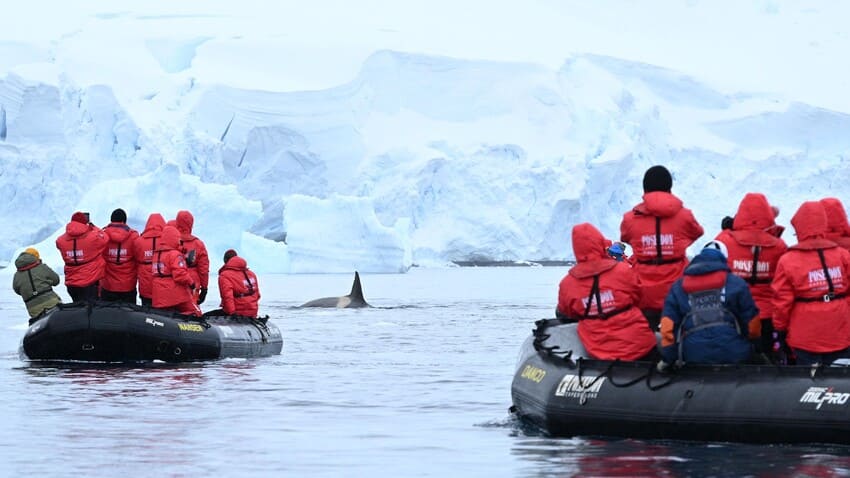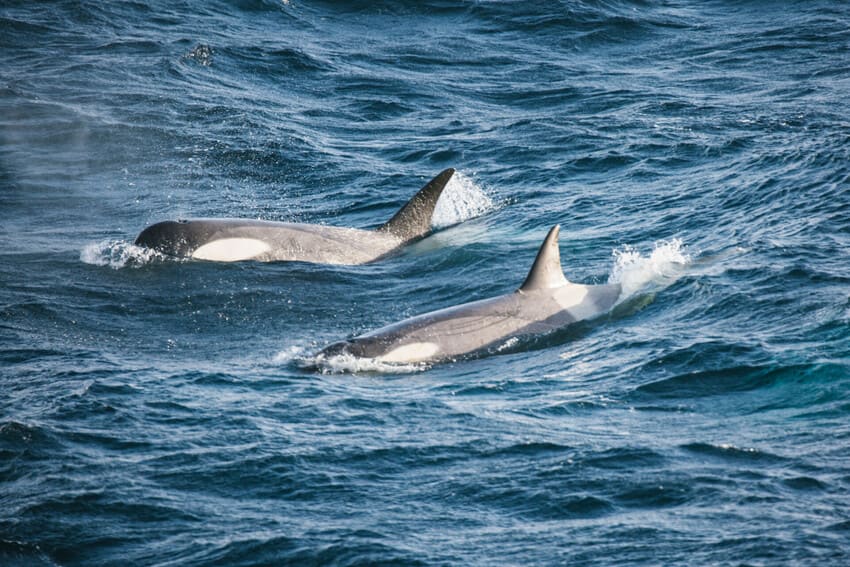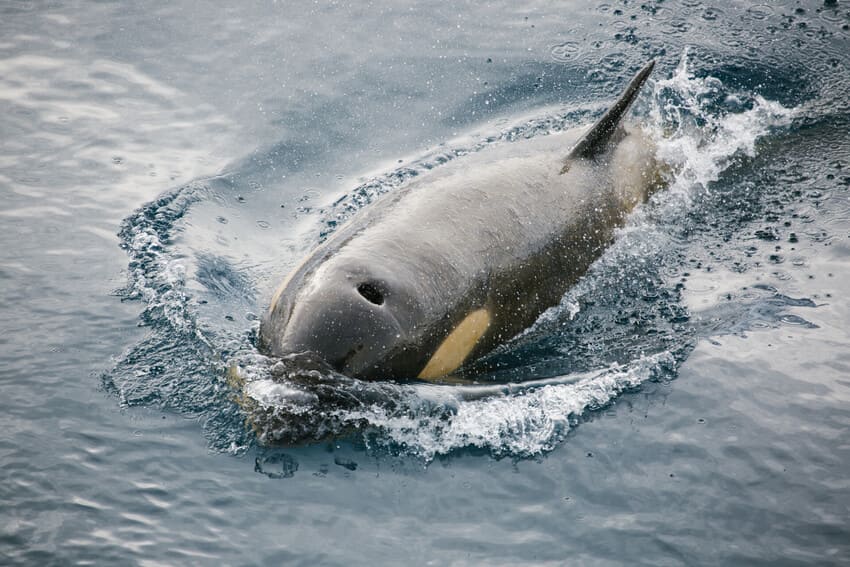Are you a novice to whale watching? Orcas are one of the easiest species to recognize when spotting whales. Look for distinctive black and white colors, a large dorsal fin and white patches around the eyes. They live in family pods, and are extremely social and intelligent. They are great communicators and can travel thousands of miles to forage for food. Want to find out more about these majestic marine mammals? Check out our 10 most interesting facts about killer whales and where to encounter them!
Fast facts:
- Scientific name: Orcinus orca
- Animal group: marine mammals
- Other names: killer whale
- Size: Adult male orcas reach a length of around 8.2 meters (27 feet) and weigh up to 6,000 kilograms (13,300 pounds), female orcas reach lengths of around 7 meters (23 feet) and weigh up to 3,600 kilograms (8,000 pounds)
- Appearance: Black with white undersides, white patches near the eyes, large paddle-shaped flippers
- Dorsal fins: Up to 2 meters long and triangular (male orca), smaller and curved (female orca)
- Locations: Worldwide
- Conservation status: Protected species (note: the southern resident killer whale population, found in the coastal waters of southern Alaska, British Columbia, Washington state and California is listed as endangered)

1 Orcas Are Very Social
It’s all about family for these complex and highly intelligent animals! Orcas usually live in pods of five to 30 individuals and have very distinctive family traditions, which include greetings, mourning, celebrations and dialects! Some ecotypes of orcas, such as resident whales, tend to have larger family groups than others. Orca pods are matriarchal and always led by the oldest female in the group. Offspring stay with their mother for their entire lives, though male orcas swim out to mate with females from other pods. Raising the young is a group activity! Once a female orca gives birth, the calf is brought up by the entire pod, and hunting and parenting skills are passed on to the young ones. And did you know that male orcas are real mommy’s boys? Scientists observed that in southern resident killer whales, females seem to forgo producing more offspring, to keep caring for their grown adult sons instead. They share their food and protect them from fights with other orcas.
2 There Are 10 Ecotypes of Orcas Worldwide
While differences in appearance may be subtle, each ecotype has its own distinctive features. Due to different feeding habits that developed over millions of years, several ecotypes of orcas emerged, featuring genetic differences caused by food preferences and availability. The five Antarctic ecotypes differ mainly by prey preferences, with some feeding on seals, while others prefer fish, penguins or minke whales. The two North Atlantic ecotypes, found around Iceland, Scotland and Norway mostly feed on fish, other whales and some types of marine mammals. The Bigg’s killer whales (also called transient whales) distinguish themselves from other orcas by living in smaller pod families. Transient whales mainly feed on marine mammals. In comparison, southern resident killer whales feature larger families and primarily feed on fish. Offshore Orcas, which live in large pods of up to 50 individuals, often feature worn-down teeth, as their diet includes sharks, known for their tough skin.
3 Their Name “Killer Whale” Originated in the 18th Century
In the 18th century, Spanish sailors spotted a group of orcas hunting other whales and large marine animals. Trying to find a suitable name for these giants, they came up with ballena asesina (whale killer in Spanish). Their Latin name, Orcinus orca, derives from Orcus (the Roman god of the underworld who is associated with death), and Orca (used to describe a large type of marine mammal). While the ferocious hunting techniques of these apex predators may have prompted such rather morbid names, orcas are known as some of the most intelligent and socially complex creatures in the world. While any whale encounter calls for caution, orcas tend not to be aggressive toward humans. Have you ever spotted an orca in real life? Based on your encounter, what would you name them?
4 Orcas Are the Largest Dolphin Species
… and dolphins, which include orcas, are part of the toothed whale species. Given their large size and iconic name (killer whale), they are often just called whales (which isn’t technically wrong, as all dolphins are whales). While dolphins usually hunt small fish and squid, orcas dominate the marine food chain, feeding on seals, sharks and even other whales. Orca and dolphin relations are complicated. Although part of the dolphin family, orcas can prey on other dolphins. But there are also friendly encounters and, in some cases, they may interact playfully with their smaller cousins.

5 They Hunt Using Echolocation
Killer whales can detect prey from distances of up to 150 meters (500 feet) using echolocation. These underwater sounds consist of clicks, which bounce back as echoes from the prey. It also helps with navigation, especially in dark and murky waters. Did you know that underwater noise from ships can interfere with an orca’s navigation skills and disturb its hunt? Speed restrictions for vessels, the use of quieter ship engines and the establishment of protected areas help protect these incredible animals.
6 Orcas Are Chatty Fellows
They do not only rely on underwater sounds to locate their prey, but also communicate with other members of the pod via clicks, pulsed calls and whistles. Orcas use their nasal sacs within their blowholes to communicate (since they lack vocal cords), and create sounds by moving air through them. Did you know that Orcas have distinct languages? Killer whales belonging to different ecotypes have their very own accents, connected to their specific feeding behavior. While offshore killer whales (which prefer marine mammals as food) hunt in silence, resident killer whales (feeding on fish) emit clicks while chasing their prey, as fish can’t pick up their frequency. Additionally, each pod has its own unique dialect, which young orcas learn from older family members. And communication includes long-distance calls! Orcas can talk with their pod from around 12 kilometers (over 7 miles) away.
7 Orcas Sleep With One Eye Open
Orcas can shut down half of their brain hemisphere, and they do so when they sleep! As killer whales are voluntary breathers, they need to keep their brain partially active to keep breathing, even during rest time. While sleeping, the eye connected to the awake side of the brain remains open. This ingenious skill is called unihemispheric sleep and also lets orcas regulate their body temperature and stay aware of their surroundings while napping. And they aren’t the only ones who master this unique skill. Walruses, whales, other dolphins, steller sea lions, crocodiles and chickens practice unihemispheric sleep.
8 You Can Find Them All Over the World’s Oceans
While killer whales prefer colder waters, they roam the Earth’s oceans and can even be spotted in locations like the Caribbean Islands! In comparison to other whales, orcas’ migration patterns depend on where their preferred prey is abundant. Depending on the specific ecotype of Orcinus orca, this can be Antarctica, the Arctic or subtropical and tropical waters. Southern resident killer whales, for example, migrate seasonally to follow salmon, which is their main prey. While Chinook salmon used to be abundant in the Salish Sea during the spawning season in summer, recent years have shown a decrease in fish, pushing southern residents to adjust their migration routes accordingly.
If you want to get the chance to encounter these majestic giants, board one of our iconic cruises to the Arctic (Greenland and Iceland) or Antarctic. The large open deck aboard our expedition ship, the Sea Spirit, is perfect for whale watching!
9 Southern Resident Killer Whales Are Critically Endangered
While collectively around 50,000 orcas roam the planet’s waters, the southern resident ecotype found in the Pacific Northwest faces extinction. As of 2025, there are only 73 animals left across three pods, and conservation efforts focus on determining threats to their existence, as well as how to mitigate them. Vessel traffic and noise from ships disturbs their feeding habits and ocean pollution harms their reproductive and immune systems. In addition to that, populations of Chinook salmon, which is the main food source of southern residents, have declined over the past decade.
10 They Are Masters of Longevity
…especially female orcas! While male killer whales live around 30 to 60 years in the wild, their female counterparts can reach 90 years of age! But there’s bad news for orcas kept in captivity. Killer whales in marine theme parks often only reach 20 to 30 years of age. While the exact causes of the early death of marine park residents are not entirely known, scientists understand that their health is compromised when deprived of a life out in the ocean. According to a 2017 study by the Archives of Oral Biology journal, captives showed severe tooth damage with exposed nerves and high risks of infection, caused by stressed animals grinding their teeth on tank walls. In addition to that, orcas in captivity are mostly kept in solitary or artificial social groups, while their natural lifestyle features socially complex family structures, with grown-up offspring staying with their moms for life.

FAQs
Why is an orca a killer whale?
Spanish sailors of the 18th century gave orcas this name (asesina de ballenas, translated into English as “whale killer”) as they observed killer whale groups hunting and preying on other whale species.
How many orcas are left in the world?
Currently, there are around 50,000 killer whales (Orcinus orca) worldwide.
Are there only 73 orcas left?
Among the southern resident killer whales, a unique killer whale population in the Eastern North Pacific region, only 73 animals have been identified worldwide as of January 2025.
Are orca whales friendly?
Killer whale (Orcinus orca) encounters with humans are often peaceful. Killer whales are known to be playful and curious around people and show no aggression. However, these reputed gentle giants are still apex predators and caution should be applied during encounters.




